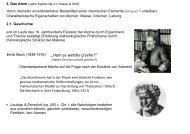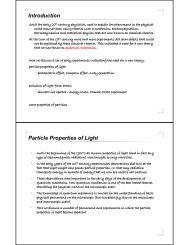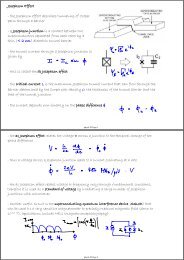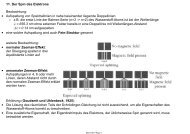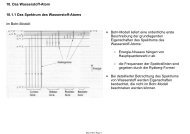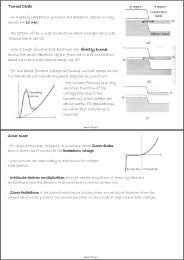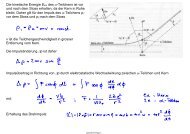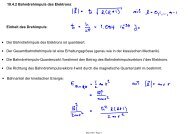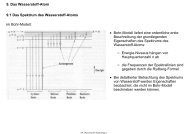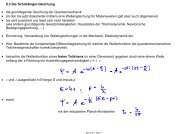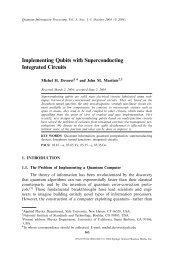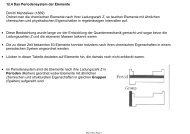Filling of Electronic States - usual filling sequence: - consider ...
Filling of Electronic States - usual filling sequence: - consider ...
Filling of Electronic States - usual filling sequence: - consider ...
You also want an ePaper? Increase the reach of your titles
YUMPU automatically turns print PDFs into web optimized ePapers that Google loves.
<strong>Filling</strong> <strong>of</strong> <strong>Electronic</strong> <strong>States</strong><br />
- <strong>usual</strong> <strong>filling</strong> <strong>sequence</strong>:<br />
1s 2 2s 2 2p 6 3s 2 3p 6 4s 2 3d 10 4p 6 5s 2<br />
4d 10 5p 6 6s 2 4f 14 5d 10 6p 6 7s 2 6d 10 5f 14<br />
- <strong>consider</strong> potassium (K): the 4s shell is filled<br />
before the 3d shell because <strong>of</strong> the stronger<br />
binding <strong>of</strong> the 4s electrons<br />
- the transition elements have electrons in the<br />
3d or 4d subshells respectively<br />
- the lanthanides (rare earths) have identical<br />
5s 2 5p 6 6s 2 configurations and differ by the<br />
number <strong>of</strong> electrons in the in the 4f shell<br />
- the actinides have identical 6s 2 6p 6 7s 2 configurations and differ only in the 5f and 6d<br />
electrons<br />
- for both lanthanides and actinides the chemical properties are dominated by the outer s and<br />
p electrons and thus result in very similar properties for all <strong>of</strong> them<br />
phys4.10 Page 1<br />
Hund's Rule<br />
When <strong>filling</strong> electrons in any subshell spins first remain unpaired in every quantum state<br />
and have parallel spin.<br />
examples: Z configuration spin <strong>of</strong> p electrons<br />
Boron 5 1s 2 2s 2 2p 1<br />
Carbon 6 1s 2 2s 2 2p 2<br />
Nitrogen 7 1s 2 2s 2 2p 3<br />
Oxygen 8 1s 2 2s 2 2p 4<br />
Fluorine 9 1s 2 2s 2 2p 5<br />
Neon 10 1s 2 2s 2 2p 6<br />
note:<br />
- The Coulomb repulsion between electrons gives rise to Hund's rule. Electrons with the same<br />
spin in the same subshell must have different magnetic quantum numbers m l which have<br />
different spatial distributions minimizing the overlap and thus the Coulomb energy.<br />
- ferromagnetism <strong>of</strong> the 3d metals iron (Fe 26 ), cobalt (Co 27 ) and nickel (Ni 28 ) is a<br />
con<strong>sequence</strong> <strong>of</strong> Hund's rule<br />
Fe 26 1s 2 2s 2 2p 6 3s 2 3p 6 4s 2<br />
3d 6 phys4.10 Page 2
phys4.10 Page 3<br />
Spin Orbit Coupling<br />
The interaction between the spin magnetic moment <strong>of</strong> an electron with its orbital angular<br />
momentum is called spin-orbit coupling.<br />
- this effect gives rise to fine structure doubling <strong>of</strong> spectral lines<br />
classical model:<br />
- <strong>consider</strong> electron moving around<br />
nucleus with charge +Ze<br />
- in the reference frame <strong>of</strong> the electron<br />
the positively charged nucleus<br />
generates a magnetic field B<br />
- the spin magnetic moment μ B <strong>of</strong> the electron interacts with that field giving rise to a<br />
potential energy <strong>of</strong> the electron spin<br />
- every electron state with orbital angular momentum will be split into two substates<br />
phys4.10 Page 4
Spin orbit coupling in hydrogen<br />
- nuclear field<br />
- mean radius<br />
- orbit frequency<br />
- for an electron in a 2p state<br />
phys4.10 Page 5<br />
Total Angular Momentum<br />
Each electron in an atom contributes with its orbital angular momentum L and its spin<br />
angular momentum S to the total angular momentum J <strong>of</strong> the atom.<br />
- <strong>consider</strong> the simple case <strong>of</strong> atoms with a single electron in the outer shell, i.e. all group I<br />
elements (H, Li, Na, K, ... ) and ions such as He + , Be + , Mg + , B 2+ , Al 2+ etc.<br />
- in these atoms the total angular momentum is given by<br />
- with the magnitude<br />
- and z-component<br />
- the simultaneous quantization <strong>of</strong> L, S and J allows only for certain relative orientations to<br />
be allowed<br />
- for one electron atoms there are only two relative positions possible<br />
phys4.10 Page 6
Relative orientation <strong>of</strong> L and S in one electron<br />
atoms<br />
- two possibilities:<br />
quantization <strong>of</strong> total<br />
angular momentum J for<br />
the two possibilities <strong>of</strong><br />
coupling between L and S<br />
phys4.10 Page 7<br />
Precession <strong>of</strong> angular moments<br />
without external field:<br />
- the magnitude and direction <strong>of</strong> J is conserved<br />
- L and S precess around J<br />
with external magnetic field B:<br />
- J precesses around B<br />
- J z is quantized<br />
- L and S precess around J<br />
- this gives rise to the anomalous Zeeman<br />
effect<br />
phys4.10 Page 8
LS coupling<br />
- in many electron atoms the total angular momentum J is the vector sum <strong>of</strong> the individual<br />
orbital angular moments L i and spin angular moments S i<br />
in most <strong>of</strong> the many electron atoms<br />
- the individual orbital angular moments L i are observed to couple to a resultant orbital<br />
angular moment L<br />
- the individual spin angular moments S i couple to the resultant spin angular<br />
momentum S<br />
- the moments then interact via the spin orbit coupling to form the total angular<br />
momentum J<br />
the angular momentum magnitudes L, S, J and their z-components L z , S z , J z are quantized<br />
in the <strong>usual</strong> way with their respective quantum numbers<br />
phys4.10 Page 9<br />
quantization rules:<br />
note that the resultant angular<br />
moment quantum numbers are<br />
indicated by capital letters,<br />
whereas the individual electron<br />
quantum numbers are not<br />
capitalized<br />
note: - L and M L quantum numbers are always integer or 0<br />
- all other quantum numbers are half integer for an odd number <strong>of</strong><br />
electrons<br />
- and integer or 0 for an even number <strong>of</strong> electrons<br />
- for L > S the total angular momentum J can have 2S + 1 different values<br />
- for L < S the total angular momentum J can have 2L + 1 different values<br />
phys4.10 Page 10
Hyperfine structure<br />
- atomic nuclei also have intrinsic angular moments and magnetic moments<br />
- these also contribute to the total angular moments<br />
- the angular moments are small and thus make only small (but observable and also useful)<br />
contributions to the total energy <strong>of</strong> electrons<br />
- the three sources <strong>of</strong> angular momentum in an atom<br />
phys4.10 Page 11<br />
Term Symbols<br />
- as for single electron states symbols are used to indicate the total orbital angular<br />
momentum <strong>of</strong> a many electron atom<br />
- in this case capitalized letters are used<br />
- a superscript number before the letter indicates the multiplicity <strong>of</strong> the state, i.e. the number<br />
<strong>of</strong> possibilities to combine the total L and total S to a total angular momentum J<br />
- for L > S the total momentum ranges from L - S to L + S, i.e. the multiplicity is 2 S + 1<br />
- in the situation S = 0 the multiplicity is 1, hence there is only one state with J = L that is<br />
called a singlet<br />
- for S = 1/2 there is a doublet state (L+ 1/2, L - 1/2)<br />
- for S = 1 there is a triplet state (L+ 1, L, L - 1)<br />
phys4.10 Page 12
- for S > L the multiplicity is given by 2 L + 1<br />
- the total angular momentum <strong>of</strong> the state realized is then indicated by a subscript after<br />
the letter<br />
- example: 'doublet P three halves'<br />
- in atoms with a single outer shell electron the principal quantum number is used as a<br />
prefix<br />
- e.g. in sodium (Na)<br />
phys4.10 Page 13<br />
Find the different possible values <strong>of</strong> J for two electrons in with orbital quantum numbers<br />
l 1 = 1 and l 2 = 2 and spin quantum numbers s 1,2 = ± 1/2.<br />
- three different possibilities to form L = |l 1 - l 2 | … |l 1 + l 2 | = 1, 2, 3<br />
- two possibilities to form S = |s 1 - s 2 | … |s 1 + s 2 | = 0, 1<br />
- orbital and spin angular<br />
moments<br />
- five possibilities to form J = |L - S| … |L + S| = 0, 1, 2, 3, 4<br />
phys4.10 Page 14
Hydrogen (H, Z = 1) Spectrum:<br />
- states labeled by n and l<br />
- selection rule: Δl = ± 1<br />
detailed structure <strong>of</strong> n = 2 and<br />
n = 3 states:<br />
- splitting <strong>of</strong> H α line into 7 sub<br />
lines<br />
- states with same n and different<br />
j have different energies<br />
- also states with same n and j but<br />
different l have different energies<br />
Lamb shift (discovered 1947)<br />
between 2 2 S 1/2 and 2 2 P 1/2<br />
phys4.10 Page 15<br />
Sodium (Na, Z = 11) Spectrum:<br />
- electron configuration 1s 2 2s 2 2p 6 3s 1<br />
- single outer s electron in potential <strong>of</strong> nucleus<br />
screened by closed inner shells<br />
- spectrum similar to that <strong>of</strong> Hydrogen for large l<br />
states (3d, 4f, 5f, 6f)<br />
- lower angular momentum states have higher<br />
probability densities close to the nucleus, resulting<br />
in stronger binding and thus lower energies<br />
single electron atom<br />
radial electron<br />
probability densities<br />
P(r) dr in dependence<br />
on angular quantum<br />
number l<br />
phys4.10 Page 16
Helium (He, Z = 2 ) spectrum:<br />
selection rules:<br />
- 2 electrons in the 1s ground state<br />
- LS coupling is dominant<br />
- in single electron transitions ΔL = 0 is<br />
forbidden and Δl = ± 1 = ΔL is required<br />
- for initial states J = 0, J has to change by<br />
±1<br />
- no radiative spin transitions between para<br />
and ortho Helium (ΔS = 0), only<br />
transitions by collisions<br />
- no n = 1 triplet due to exclusion principle<br />
- large binding energies<br />
- largest ionization energy <strong>of</strong> any element<br />
phys4.10 Page 17<br />
Mercury (Hg, Z = 80) spectrum:<br />
- 2 outer shell electrons, 78 closed subshell inner electrons<br />
- spectrum shown for one <strong>of</strong> the two electrons in lowest energy state<br />
- singlet (S=0) and triplet (S=1)<br />
states <strong>of</strong> outer shell electrons are<br />
observed<br />
- violation <strong>of</strong> ΔS = 0 selection rule, e.g.<br />
in 3 P 1 -> 1 S 0 transitions<br />
- violation <strong>of</strong> ΔS = 0 selection rule and<br />
ΔJ = 0 rules in 3 P 2 -> 1 S 0 and 3 P 0 -><br />
1<br />
S 0 transitions<br />
- break-down <strong>of</strong> LS coupling is<br />
observable<br />
- in high Z atoms JJ coupling<br />
dominates<br />
phys4.10 Page 18
Experiment Mercury (Hg) Spectrum:<br />
* yellow (579.1 nm) visible line 6 1 D 2 -> 6 1 P 1<br />
** green (546.1 nm) visible line 7 3 S 1 -> 6 3 P 0<br />
*** blue (435.8 nm) visible line 7 3 S 1 -> 6 3 P 1<br />
**** UV line(253.7 nm) visible line 6 3 P 1 -> 6 1 S 0<br />
phys4.10 Page 19



